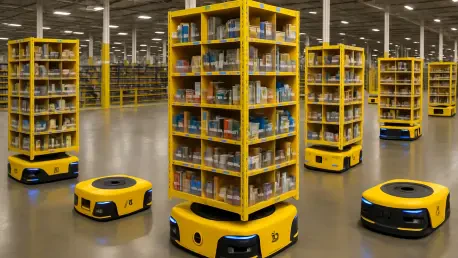Picture a warehouse where millions of packages move with uncanny precision, sorted and shipped at a pace that seems almost inhuman, a reality now unfolding in Amazon’s distribution centers across the United States. This is no longer a distant vision but a tangible transformation. At a recent Silicon Valley event dubbed “Delivering the Future,” the company showcased a fleet of AI-powered robots designed to revolutionize logistics. The speed and scale of this transformation raise a pressing question: how will this cutting-edge technology reshape the balance between efficiency and human labor in one of the world’s largest employers?
The Urgency of Speed in E-Commerce
The e-commerce boom has placed unprecedented demands on companies to deliver goods faster and at lower costs. With Amazon processing millions of orders daily, the race to streamline operations has become a defining challenge. This isn’t just about meeting customer expectations—it’s about survival in a fiercely competitive market. As the second-largest employer in the U.S., Amazon’s push for automation through AI and robotics signals a broader shift in the supply chain industry, where efficiency often dictates success.
Labor shortages and rising consumer demands add another layer of complexity to this equation. Traditional methods of warehouse management struggle to keep up with the sheer volume of transactions, especially during peak seasons like holidays. The stakes are high, and Amazon’s latest technological advancements are positioned as a solution to these mounting pressures, promising to redefine what’s possible in logistics while navigating the delicate balance of workforce stability.
Inside the Tech: Amazon’s Robotic Revolution
Amazon’s new arsenal of AI-driven robots represents a leap forward in operational precision. Among the standout innovations are the Blue Jay Robotic Arms, currently under testing in South Carolina. These arms are engineered to handle multiple tasks—picking, sorting, and consolidating items—at a single workstation, drastically reducing bottlenecks that slow down fulfillment processes. The result is a smoother, faster workflow that can keep pace with soaring order volumes.
Another key player is the Vulcan Robot, rolled out earlier this year, which introduces a sense of touch to order handling. This capability ensures delicate items are managed with care, addressing a long-standing challenge in automation. Beyond the warehouse, Amazon is integrating AI across its logistics chain, from camera-equipped smart glasses that guide delivery drivers with real-time instructions to AI agents that coordinate human-robot collaboration. Backed by data showing a two-thirds reduction in development time for Blue Jay—down to just over a year—these tools underscore how rapidly technology is transforming Amazon’s operations.
Expert Insights and Hard Numbers
Tye Brady, Amazon Robotics chief technologist, is a vocal advocate for these innovations, emphasizing their role in enhancing the workplace. He argues that AI and robotics create jobs that are “safer, smarter, and more rewarding” for employees, pushing back against concerns of widespread job displacement. Brady also highlights Amazon’s track record of job creation, noting that the company has added more positions in the U.S. than any other corporation over recent years, suggesting automation complements rather than replaces human labor.
However, not all perspectives align with this optimism. A report from a leading national newspaper estimates that automation could allow Amazon to bypass hiring up to 160,000 workers over the next two years, particularly for temporary roles during high-demand periods. This figure casts a shadow over claims of job security, pointing to a potential reduction in seasonal employment. Balancing these viewpoints, it’s evident that while technology drives efficiency, its impact on the workforce remains a topic of intense debate among industry observers and labor analysts.
Broader Implications of Automation
The ripple effects of Amazon’s robotic advancements extend far beyond warehouse walls. The integration of AI into logistics reflects a growing trend across industries, where repetitive tasks are increasingly delegated to machines. This shift frees up human workers for more complex roles but also demands adaptation. Businesses looking to follow in Amazon’s footsteps must reassess their operational models, identifying areas where automation can yield the greatest impact while ensuring employees are equipped to work alongside these systems.
For workers, the rise of robotics presents both challenges and opportunities. Roles tied to technology—such as maintaining robots or analyzing operational data—are becoming critical, signaling a need for upskilling. Educational programs and on-the-job training could bridge this gap, preparing the workforce for a landscape where human ingenuity and machine efficiency intersect. The broader implication is clear: adaptation is no longer optional but a necessity for staying relevant in an automated era.
Preparing for an Automated Tomorrow
As automation becomes a cornerstone of modern logistics, both companies and employees must chart a path forward. Businesses can start by pinpointing tasks that are repetitive and time-intensive, integrating AI solutions to boost productivity while minimizing disruption. Collaboration between human teams and robotic systems should be prioritized, with training programs designed to foster seamless interaction. This strategic approach can help organizations harness the benefits of technology without alienating their workforce.
Employees, on the other hand, can take proactive steps to remain indispensable in this evolving environment. Learning skills related to AI oversight, system maintenance, or data interpretation can open doors to new career paths within automated settings. Industry partnerships with educational institutions could further support this transition, offering certifications and workshops tailored to emerging needs. The focus must be on building resilience and versatility in a job market increasingly shaped by technological progress.
Looking back, the unveiling of Amazon’s AI robots at the Silicon Valley event marked a pivotal moment in the journey of warehouse automation. The showcased innovations, from Blue Jay Robotic Arms to Vulcan’s tactile precision, demonstrated a clear commitment to efficiency. Reflecting on the insights shared by experts like Tye Brady and contrasting data on potential job impacts, a nuanced picture emerged—one of promise tempered by caution. Moving forward, the industry must prioritize collaborative frameworks where technology enhances human potential, ensuring that the march toward automation also paves the way for inclusive growth and sustainable employment solutions.









